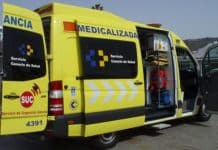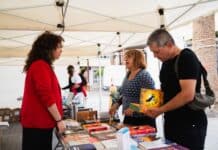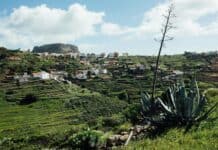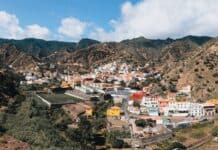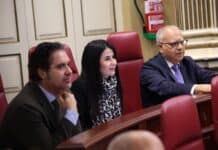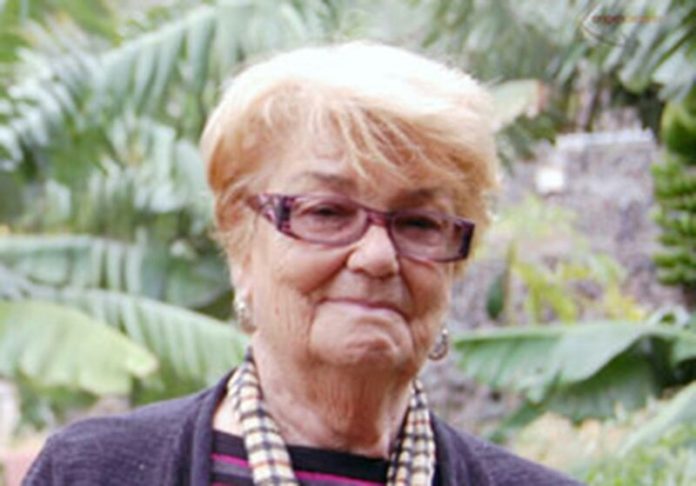Los Telares es hoy día una empresa dedicada a su Parque Etnográfico, venta de artículos de artesanía y alquiler de apartamentos y casas rurales. Esta emblemática empresa del norte de la isla la fundó en los años 70 Maruca Gámez, y actualmente la lleva su única hija y su familia. En esta ocasión conversamos con Luisa, la hija de Maruca, para conocer un poco mejor su historia.
«Los Telares fue un antes y un después en nuestra familia. Mi madre era maestra, la maestra de toda la vida de un pueblo pequeño. Por entonces, mi mundo era el Colegio, como estudiante e hija. Pero cuando tenía 15 años todo cambió. Mi madre descubrió su vocación como empresaria y ya a partir de entonces se comía, se dormía y se amanecía con la empresa, con todo lo que suponía entonces montar una empresa y emprender».
«Definitivamente, abrir una empresa era difícil en esa época. Entonces, durante los años 70, no era como ahora. Imagínate la revolución que suponía abrir una empresa moderna en Hermigua y ¡siendo mujer, ni más ni menos!”
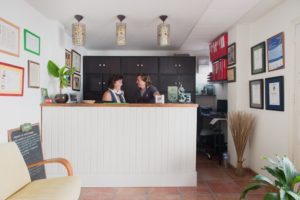 “Desde entonces emprender nos contagió a todos, ¡hasta una de mis hijas ha montado eeverde.com, una escuela online de formación en Energías Renovables! Con eso ya se nota que somos unos apasionados de la sostenibilidad. Yo en 1993 abrí uno de los primeros herbolarios de Santa Cruz. Lo dirigí durante 10 años hasta que lo traspasé porque mi madre me necesitaba».
“Desde entonces emprender nos contagió a todos, ¡hasta una de mis hijas ha montado eeverde.com, una escuela online de formación en Energías Renovables! Con eso ya se nota que somos unos apasionados de la sostenibilidad. Yo en 1993 abrí uno de los primeros herbolarios de Santa Cruz. Lo dirigí durante 10 años hasta que lo traspasé porque mi madre me necesitaba».
«Su legado a la artesanía de la isla fue y sigue siendo muy importante. Las primeras piezas elaboradas con platanera que se hicieron en la isla las elaboró mi madre ayudada por Lili Ascanio. Entonces en Andalucía había unas muñecas y unos burritos de soga. Y se inspiraron en eso para hacer algo aquí con producto local. Así empezaron a hacer las flores con la hoja de platanera. ¡Yo me acuerdo de reuniones de 20 mujeres en Vallehermoso! Mi madre compraba el material, y se sentaba allí a trabajar con ellas y probar diseños».
«Era una época difícil para toda la isla, La Gomera estaba en crisis y Tenerife, Venezuela… eran donde las familias se trasladaban para mejorar su vida. La «chispa» que generó la idea del taller y la tienda fue una conversación con Tomás Cerdeña. Él le comentó a mi madre que iban a empezar a hacer excursiones de día por la isla. Un barco haría la ruta de ida y vuelta durante el mismo día, algo que no sucedía antes. Buscaban sitios donde llevar a los excursionistas para que pudieran comprar algo de la isla. Dicho y hecho. En un mes ya tenía montada la primera tienda».
«El crecimiento a partir de entonces fue imparable. La Gomera fue un descubrimiento para los turistas. Cada vez venían más y más excursiones, era increíble. ¡Nuestra preocupación era conseguir suficiente artesanía para vender! Al poco apareció una agencia alemana preguntando por alojamientos para senderistas, y mi madre no tuvo que pensárselo mucho. Les pidió un año de plazo. Y al año ya tenía los primeros apartamentos».
«A día de hoy gran parte de nuestro esfuerzo está en mejorar lo que ya tenemos, que son muchos años y renovarse es crucial”.
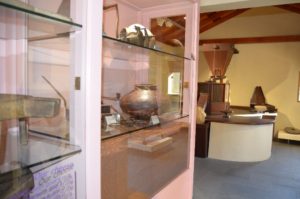 “Los Telares surgió de la artesanía, del territorio, y como función social: para que no se perdiera la artesanía, la cultura gomera. Hemos renovado el concepto de la tienda, la hemos vinculado al territorio y hemos creado así el Parque Etnográfico, que es el proyecto que tenemos ahora en marcha y que va creciendo y madurando poco a poco. Parece una idea muy alejada de ese taller de los años 70. Pero el Parque Etnográfico es la respuesta a una necesidad moderna. Hoy día la gente no entiende realmente lo que supone la artesanía. Si antes explicabas la pieza dentro de la tienda, ahora también pueden recorrer las terrazas de plataneras, ver las antigüedades de nuestra colección, el molino de gofio funcionando… Explicar así el modo de vida tradicional les devuelve valor, como cultura y como esfuerzo, a los ojos del visitante».
“Los Telares surgió de la artesanía, del territorio, y como función social: para que no se perdiera la artesanía, la cultura gomera. Hemos renovado el concepto de la tienda, la hemos vinculado al territorio y hemos creado así el Parque Etnográfico, que es el proyecto que tenemos ahora en marcha y que va creciendo y madurando poco a poco. Parece una idea muy alejada de ese taller de los años 70. Pero el Parque Etnográfico es la respuesta a una necesidad moderna. Hoy día la gente no entiende realmente lo que supone la artesanía. Si antes explicabas la pieza dentro de la tienda, ahora también pueden recorrer las terrazas de plataneras, ver las antigüedades de nuestra colección, el molino de gofio funcionando… Explicar así el modo de vida tradicional les devuelve valor, como cultura y como esfuerzo, a los ojos del visitante».
«Nuestra relación con la Carta Europea de Turismo Sostenible comenzó, efectivamente, con la primera oleada de acreditaciones. A mí me llegó un correo explicando que La Gomera iba a tener la figura de Carta Europea de Turismo Sostenible. Cuando eso sucedió aún vivía en Tenerife. Como a mí la ecología y la sostenibilidad es algo que me parece imprescindible, me llamó mucho la atención. Luego acudí a la primera reunión y salí encantada».
«La carta nos ha animado a hacer encuestas a nuestros clientes y tomarnos muy en serio lo que indican. Estamos muy orgullosos de que el cliente sea el que nos guíe, ¡nos encanta! A nosotros nos lo hace más fácil. En vez de romperte la cabeza pensando cómo mejorar, con hacerle caso a lo que te están diciendo tus clientes es suficiente. En ocasiones vamos más allá, buscamos darles más de lo que nos piden, pero siempre nos inspiran ellos con sus comentarios».
«Como persona, también he cambiado gracias a la Carta. Seguro que todavía la gente mayor del pueblo te pregunta «¿Y tú de quién eres?». Es un modo de definirte, de colocarte en el paisaje en función de tus raíces, de tu familia. A mis años, aún me tengo que presentar como la hija de Maruca. Porque aquí cada uno es de su pueblo, y de su barrio, y si me apuras, de su familia y poco más”.
“Ser empresa CETS me supuso sentirme, quizás por primera vez, y ante todo, de La Gomera. La Carta fue una llamada de atención. Nos recuerda que estamos todos en el mismo barco, nos ayuda a ser isla, a estar unidos y a hacer territorio. Hemos conectado con empresas de toda la isla, hemos trabajado juntos y, algo muy importante, nos han ayudado a sentirnos menos solo en nuestro esfuerzo».
«Pero más del Parque Nacional, eso no. El Parque Nacional para mí siempre ha sido el corazón de la isla. Y dentro del corazón, su alma es el bosque del Cedro, donde pasé los veranos de mi infancia. En el incendio de hace cinco años lo único que podía pensar era que por favor no llegara a El Cedro. Habría sido como si la isla entera se hubiera perdido con las llamas. Lo que sí me ha facilitado la Carta es algo de lo que estoy muy orgullosa, que es aportar lo que puedo, como vecina y como empresaria, para que el alma de La Gomera se siga conservando».
Empresa: Los Telares.
Actividad: Alojamiento y Parque Etnográfico.
Dirección: Carretera General, nº 10. Hermigua.
Teléfono: 922 88 07 81
 My mother was the village’s teacher
My mother was the village’s teacher
Los Telares is nowadays a company running an Ethnographic Park, selling handicrafts and renting rural apartments. This emblematic northern island company was founded in the 1970’s by Ms. Maruca Gámez, and is currently run by her only daughter Luisa and family. We have interviewed Luisa to learn a little bit more about this enterpreneur family.
«Los Telares marked a turning point in our family. My mother was the teacher, the traditional school teacher in a small town. Back then my whole world was the school, both as a student and daughter. But everything changed when I was 15 years old. My mother discovered her calling as a businesswoman and from them we would eat, go to sleep and rise with the company, with everything that implied to run and grow a business».
«Definitely, opening a company was terribly difficult. It wasn’t like it is right now, it was the 70’s. Just imagine the outrage, starting a modern company in Hermigua, and run by a woman, nonetheless! But being an enterpreneur is contagious, even my daughter has set up her own company, eeverde.com, an online Renewable Energies School! That also shows how passionate we are about sustainability. In 1993 I opened one of the first Herbalist’s shops in Tenerife. I owned it for 10 years until my mother asked for help here».
«Her legacy to handicrafts was and remains crucial. The first banana leaves pieces made in the island were designed by my mother with the help of Lili Ascanio. Back then in Andalusia they sold rope dolls and donkeys. Those inspired them to make some similar here. They made the banana leaf flowers. I remember meetings of up to 20 women in Vallehermoso! My mother bought the banana and would sit with them to work and try new designs».
«Those were terrible times for the island. La Gomera was in deep crisis and Tenerife, Venezuela… whole families moved there to improve their lives. The «spark» that ignited everything was a conversation with Tomás Cerdeña. He mentioned to my mother that the island would soon be receiving their first daily tourists. A ferry would link Tenerife and La Gomera on the same day, something impossible up to then. He was looking for places where he could take tourists to buy souvenirs on La Gomera. Said and done. In a month her first shop was open for business».
 «La Gomera was a sensational discovery for visitors. Tours just kept growing. Our only worry was getting enough products to sell! Shortly afterwards, a German agency asked about lodgings for trekkers, and my mom jumped in into the opportunity. She just requested one year to build them. And there: she had her first apartments».
«La Gomera was a sensational discovery for visitors. Tours just kept growing. Our only worry was getting enough products to sell! Shortly afterwards, a German agency asked about lodgings for trekkers, and my mom jumped in into the opportunity. She just requested one year to build them. And there: she had her first apartments».
«A large part of our current efforts today are in improving what we have. It has been many years and renovating is crucial».
“Los Telares grew from handicrafts, from the ties to our culture, and with a social cause: so that local crafts would not be forgotten. We have recently renovated the concept of the store, we have linked it back to it’s origin, the landscape of La Gomera. We have done so by creating our Ethnographic Park, which it the project we are fully hands-on. Modern visitors don’t fully get what handicrafts are, the effort and history they have. The Ethnographic Park was the logical consequence when trying to fill that gap. Before, we had to explain the object in the shop, but now our customers can walk through our plantation, see the antiques in the collection, enjoy a fully-functioning gofio watermill… This way of explaining our traditions add value, as culture and effort, to the eyes of our visitors».
 «I first heard about the Charter when I I was still living in Tenerife. I received an email explaning that La Gomera would become part of the European Charter. I am fully convinced of the importance of sustainable development, and the Charter was an innitiative I could relate to. Then we had the first meeting, and I was fully on board with it!».
«I first heard about the Charter when I I was still living in Tenerife. I received an email explaning that La Gomera would become part of the European Charter. I am fully convinced of the importance of sustainable development, and the Charter was an innitiative I could relate to. Then we had the first meeting, and I was fully on board with it!».
«The Charter inspired us to make surveys and take them very seriously. We are amazed ourselves with the result, we love being valued and guided by our clients! It has made everything easier. Instead of breaking your head thinking where to invest and improve, just listening to what your clients are saying is more than enough clue. We sometimes go further on, trying to deliver extra, but even then, we are inspired by their comments».
«Also as a person, I have learned plenty. Well, i’m sure, even to you, elder people would ask «Who are you from?». It is the traditional way of defining you, placing you on the landscape accordingly to your roots, your family. Even nowadays, at my age, I have to introduce myself as Maruca Gamez daughter. Because here, you belong to your town, your neighbour and, furthermore, your family, and little else».
“Becoming a ECST company made me feel, maybe for the first time, above all, Gomeran. It was a wake up call. It reminds all of us that we are on the same journey, it helps us be an island, it gathers us together. We have connected with companies from all around the island, we have worked together and, most importantly, it has made us feel less lonely in our efforts».
«But to feel more linked to the National Park, that is impossible. The National Park for me has always been the heart of La Gomera. And inside it, it’s soul is El Cedro forest, where i spent my childhood Summer holidays. I remember, while the wildifire 5 years ago, my only prayer was that the flames would not get to El Cedro. For me, that would have meant that the whole island had burned away. The Charter has allowed us to do something that I’m very proud of, which is to collaborate, to the best of our capacity, as neighbours and companies, so that the soul of La Gomera remains untouched».
Company: Los Telares.
Activity: Lodgings and Ethnographic Park.
Address: Carretera General, nº 10. Hermigua.
Phone: 922 88 07 81
Nota de la redacción: El Parque Nacional de Garajonay y la Asociación para un Turismo Sostenible en La Gomera (Atusos Gomera), remite para su publicación una nueva entrevista a otro de los 33 establecimientos turísticos de La Gomera adheridos a la Carta Europea de Turismo Sostenible (CETS).


